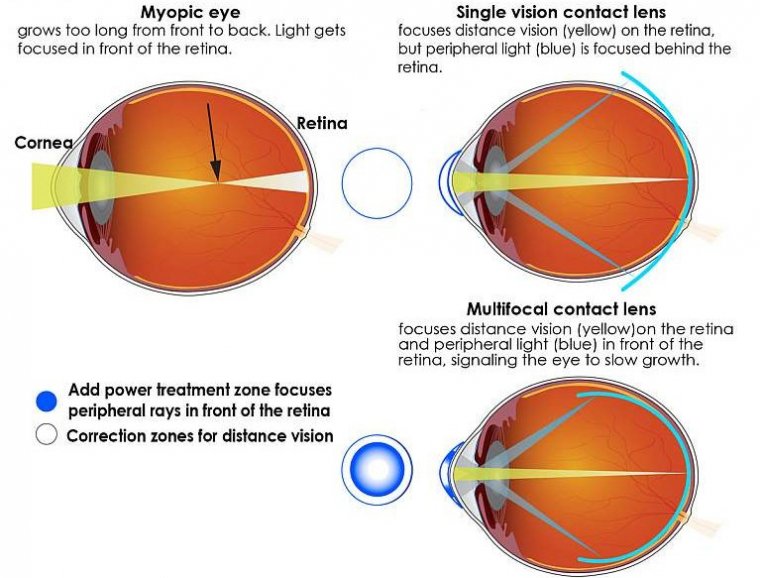| Health / Health News |
Multifocal contact lenses slow myopia progression in children
Children wearing multifocal contact lenses had slower progression of their myopia, according to results from a clinical trial. The findings support an option for controlling the condition, also called nearsightedness, which increases the risk of cataracts, glaucoma and retinal detachment later in life.

The center portion of the lens corrects nearsightedness so that distance vision is clear, and it focuses light directly on the retina. The outer portion of the lens adds focusing power to bring the peripheral light rays into focus in front of the retina. Animal studies show that bringing light to focus in front of the retina cues the eye to slow growth. Photo: National Eye Institute
“It is especially good news to know that children as young as 7 achieved optimal visual acuity and got used to wearing multifocal lenses much the way they would a single vision contact lens. It’s not a problem to fit younger kids in contact lenses. It’s a safe practice,” said Bifocal Lenses In Nearsighted Kids (BLINK) study chair, Jeffrey J. Walline, O.D., Ph.D., associate dean for research at the Ohio State University College of Optometry.
Myopia occurs when a child’s developing eyes grow too long from front to back. Instead of focusing images on the retina—the light-sensitive tissue in the back of the eye—images of distant objects are focused at a point in front of the retina. As a result, people with myopia have good near vision but poor distance vision.
Single vision prescription glasses and contact lenses are used to correct myopic vision but fail to treat the underlying problem. Multifocal contact lenses – typically used to improve near vision of people over the age of 40 years – correct myopic vision in children while simultaneously slowing myopia progression by slowing eye growth.
Shaped like a bullseye, the soft multifocal contact lenses have two basic portions for focusing light. The center portion of the lens corrects nearsightedness so that distance vision is clear, and it focuses light directly on the retina. The outer portion of the lens adds focusing power to bring the peripheral light rays into focus in front of the retina.
Animal studies show that bringing light to focus in front of the retina cues the eye to slow growth. The higher the power added, the further in front of the retina it focuses peripheral light.
By comparison, single vision glasses and standard contact lenses focus peripheral light to a point behind the retina, which prompts the eye to keep growing.
The researchers examined whether high-add power contact lenses provided better slowing of myopia progression and eye growth than medium-add power contact lenses. They found that only the high-add power contact lenses produced meaningful slowing of eye growth.
In addition to multifocal lenses, other myopia control options include orthokeratology contact lenses, which are worn overnight to reshape the cornea, or low-dose atropine eye drops used at bedtime.
Reasons for the spike are unclear, but evidence suggests that near work, such as screen time, and shrinking outdoor time during early eye development are contributing factors. Genetic factors also play a role in one’s predisposition to become myopic.
There are no tests to identify which individuals with myopia will progress to high myopia, but the younger a child is affected, the more opportunity their myopia has to progress if there is no intervention to slow it. (National Institutes of Health)
YOU MAY ALSO LIKE





